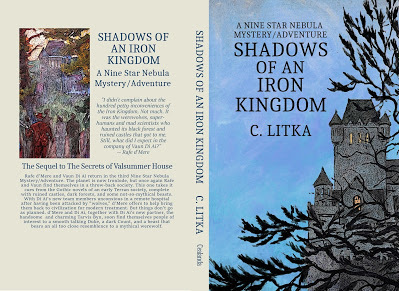C. Litka's Blog, page 43
August 15, 2021
Reading for Writing
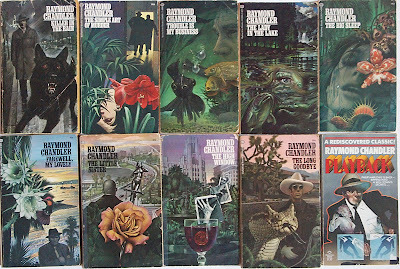 The wonderfully evocative covers (save one)
The wonderfully evocative covers (save one)As I promised in a recent post, a chance discovery of a new writer (for me) in a new genre, sometime just after my college years, changed the way I enjoyed reading. The genre was private eye fiction, and the writer was Raymond Chandler. I have no recollection of how I came to read Chandler. Perhaps it was that Humphrey Bogart played the detective hero Philip Marlowe in an adoption of his novel The Big Sleep. I was a big Humphrey Bogart fan. Or it may’ve been the Ballentine Book covers of the early 1970’s edition that enticed me to pick one up off the book rack and give it a try. In any event, I picked one up and read it – and proceeded to search out the nine, and eventually ten Chandler books Ballentine published around that time.
Why? Simply put, it was the way Chandler wrote. He could not only bring characters to life on the page, but southern California of the late 30’s and 40’s with a mix of neon and grime. In all my previous reading I had never encountered an author who could draw on so much of the English language and use it in his “hard boiled” dialogue. Somehow lyric descriptions of place and time, riddled with original similes could still sound hard boiled. His Los Angeles and Bay City were as alien to me as any SF world – brought to life with such vigor and wit. And the character of Philip Marlowe was also so vividly brought to life – a hard boiled private detective with the eyes of a poet. A man of principles as well as action. While Chandler was an American, and he was writing American detective fiction, he had received a classical British education at Dulwich College and I very much believe that this education had a great influence on his writing.
In reading the books of Raymond Chandler I discovered that there was more to a story than the story. I found delight in the way Chandler put words together. This delight in playfully putting words together has stayed with me all these years. I care less about the story than the words used to convey it.
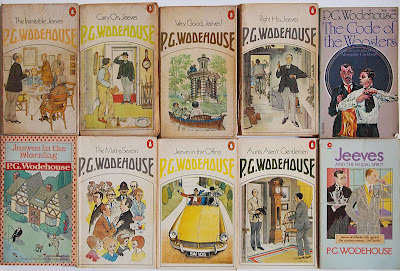 In my mind, the Penguin books with covers by "Ionicus" bring to life the classic Wodehouse world.
In my mind, the Penguin books with covers by "Ionicus" bring to life the classic Wodehouse world.And around the same time, I discovered another writer who delighted me in much the same way – his creative use of the English language in an entirely different genre. Like Chandler, P G Wodehouse had graduated from Dulwich College a few years before Chandler. Wodehouse’s comic stories, particularly, the Bertie Wooster & Jeeves stories, are in my opinion some of the best written fiction in the English language. They may not plumb the depths of the human experience, but for putting words together to create characters, scenes, and stories, I doubt that there are many better. Wodehouse produced more than 90 books 40 plays and 200 short stories and other writing in his life time. The quality of his work varied, and many books had similar plots, but at his best, his lighthearted stories could not be topped.
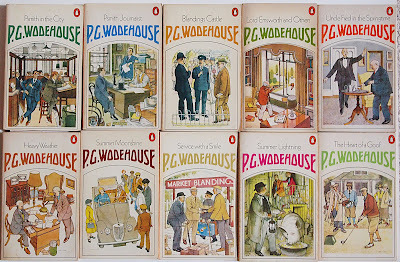 More covers by Ionicus
More covers by Ionicus
Between Chandler and Wodehouse, I discovered the joy of playing with words to produce clever, witty writing that made any story a delight to read, and reread again and again. Nothing I had read in SF up to that date could equal the pure delight in reading produced by those two writers. As we discovered in my last post, I may not have been reading the best SF could offer, still, I doubt that many SF authors, at least up to the 1970’s could’ve offered the level of pure writing than what these two authors produced.
This is not to say that SF doesn’t have its literary writers. Gene Wolfe is often mentioned as a writer of such dense and beautiful words that may people read his books just for his writing, though the denseness of his writing can make the stories very hard to understand. I am sure that there are other SF writers which readers can put forward as excellent wordsmiths as well. Jasper Fforde and Jonathan L Howard are the two contemporary writers whose style matches my taste -- witty, clever, and laced with humor.
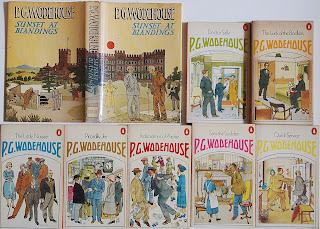 And still more Ionicus covers
And still more Ionicus coversReading Chandler and Wodehouse changed the way I read books. Even today, plot takes a distance third or fourth place, after writing, characters, and perhaps setting as well.
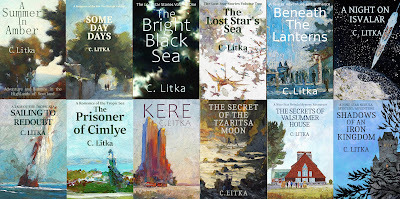
August 11, 2021
A Night on Isvalar
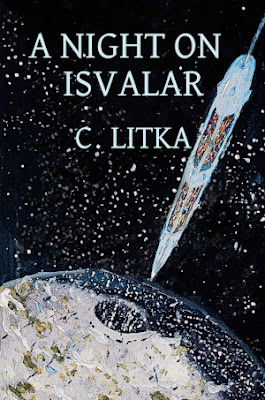
A Night on Isvalar, a 26,200 word novella, is now available as an Amazon ebook for $.99 and on Kindle Unlimited where it can be read for free. The story began its life as the first story in my “The Starfaring Life” serial in Amazon’s Vella service. After 30 days Amazon allows complete stories on Vella to be published as books, and I am taking them up on that.
This will be an Amazon exclusive story for now. I’ve been tempted to release one of my books as an Amazon exclusive to see what, if any, traction it might generate in the Kindle Unlimited program, but I never could bring myself to do that. This story, however, being more or less an Amazon exclusive already, makes it an easy choice for that experiment. I keep my expectations low, so I am not easily disappointed, so this, like the Vella experiment is mostly an exercise in free promotion for my other books. The Vella program, to date, has produced nothing for me in the way of anything, so the bar is low. And, just so you know, its $.99 price is about half of what anyone would pay to read the same story on Vella as a serial, as those readers pay a penny per 100 words rounded down, so they would end up paying nearly $2.00.
Here is the blurb for A Night on Isvalar:
It was supposed to be a quiet night. It was anything but.
Riel Dunbar grew up and sailed out of the little moon of Isvalar, the interstellar port of Aeroday, for many years. But the restless life of a starfarer took him away for decades. Chance had now brought him home with a promised long leave ashore. But it was not to be. He found that he had only a few hours to spend on Isvalar.
His plan was simple. He’d dine at an old haunt of his youth, and then, after a brief nap, he’d visit the starfarer dives of Isvalar for real spree before sailing. But Riel hadn’t counted on crossing orbits with Cera Marm, the power mate of a rival ship. Somehow he found himself entangled in her plans – plans that included not paying a gambling debt to a very persistent bookie and his hired thugs. Riel’s night on Isvalar turned into a hectic chase and escape across the little moon, with encounters with neuro-blade wielding thugs, a snake obsessed shadow-rat gang, an auton, and the bookie himself. It didn’t end well.
A Night on Isvalar is a 26,200 word novella. A version of this story first appeared in Vella under the title of The Starfaring Life & A Night On Isvalar.
C. Litka writes old fashioned stories with modern sensibilities, humor, and romance. He spins tales of adventure, mystery, and travel set in richly imagined worlds, with casts of colorful, fully realized characters. If you seek an escape from your everyday life, you will find no better company, nor more wonderful worlds to travel and explore, than in the stories of C. Litka.
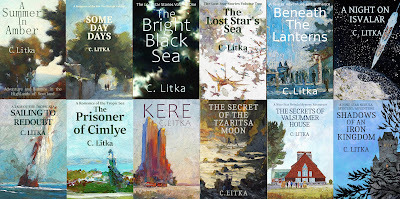
August 6, 2021
Beyond SF
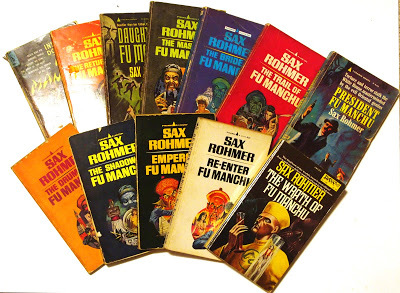
In a recent post I talked about having missed reading most of the most famous and important books in SF. In this post I will explore why that might be.
I’ve never been a reader of literary fiction. I am not curious about people or the exploration of the human condition. I try to look on life with as much humor as I can, so that books that take life very seriously or are deeply physiological or philosophical don’t appeal to me. Given my taste in reading, it is not surprising that SFF books like Dune, which take a very serious or philosophical approach to story telling, would not interest me.
Nor am I interested in reading grim, dark, or horror stories. I know a lot of readers enjoy those types of stories, but I’m not one of them. My taste in stories has always leaned towards light, popular literature. All of which might explain why I have read sofew of the most significant SF stories. However, there is one other contributing factor.
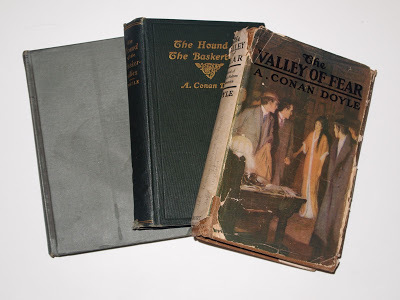
As I mentioned in my previous post, I wasn’t reading just speculative fiction, in my teen years. Looking back, it is interesting to see what I was reading besides SF, since it foreshadowed the type of stories I would enjoy my entire life, and aspire to write today. As a teenager, I was a big fan of Conan Doyle’s Sherlock Holmes stories – I read them all – and Sax Rohmer’s stories of Dr Fu Manchu, and to a much lesser extent, some of this other fiction. These were books that my Dad had around the house.
So what were the elements of Sherlock Holmes and Fu Manchu that informed my reading life? First, they were character focused stories. Sherlock Holmes and Watson, Sir Denis Nayland Smith, Dr Petrie and Dr Fu Manchu where central to these stories, not fantastic futures, philosophies or abstract ideas. They were characters that you came to know as people. Compared to many of the cardboard thin characters in many, though not all of the SF books I was reading, these characters were far more nuanced and developed. While they may not have been written on the same level of the best literary fiction characters, they possessed a certain verve that made them real. Indeed, both Sherlock Holmes and to a lesser extent, Dr Fu Manchu, are far better remembered a century later than most literary fiction characters. In any event, these stories offered characters that I could imagine as real people, not mere plot devices.
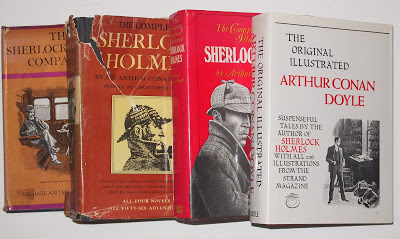
Secondly, these writers brought the romance of Victorian and Edwardian London to life in their writings. Conan Doyle accomplished this with all the various characters with their different stations of life and their unique situations that Holmes needed to investigate. Sax Rohmer’s London was a London of hidden mysteries, of the secretive Chinatown of the grimy East End, with the Thames a road of mysteries from exotic lands winding through it. Both writers knew how to create an atmosphere and infused their writing with a true sense of place, perhaps because they were writing about the London and England the knew first hand. But by the time I was reading these stories, time and distance made these versions of London as exotic and remote as any planet in SF. And perhaps because they were writing about their contemporary city, they brought an enhanced authenticity to their Londons that even the wildest imaginations of writers like Edgar Rice Burroughs could not bring to their worlds.
Of course one has to put these books in context with the SF I was reading at the time, which where often reprints of stories written in the first half of the century for the pulp magazines of the time. No doubt SF writing has grown and matured since then, but what I was reading was mostly pulp stories – especially since I had no interested in the more literary SF that was coming out in the 1960’s, books like Duneor Stand on Zanzibar, or Babel-17. So when I say that they were written in a style that was several notched above the rather nondescript writing of many of the old space opera and planetary romance stories I enjoyed, I will acknowledge that there may’ve been SF and fantasy books written at that level as well. I just wasn’t reading them.
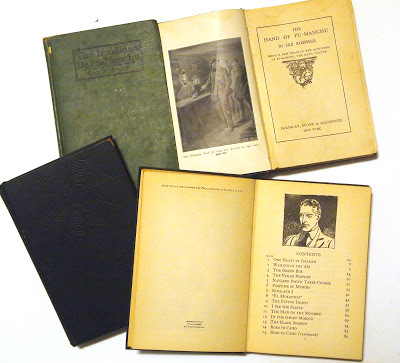
And there is, I think, one more feature of these books – they both were British authors. Even back then I found the writing of British authors seemed to be several notches above the writing of most American authors. As a result, I have found, over the years, that British, or British educated writers, are my favorite writers. Not all British writers, of course, and not all my favorites are by British authors, but most of them are. There is something about the way British writers use their language that appeals to me. And there is something about the writing of late Victorian to the first half of the 20th century authors that appeal to me, as well. They knew their language and how to use it evocatively. In my teen years, it was Conan Doyle and Sax Rohmer that carried the banner of wonderful British writers.
The next discovery in the joys of reading and writing was not delivered to me by a British author, but by a British educated American author. But I’ll save that subject for next time.
August 2, 2021
My Library -- My Old Paperback SF Books
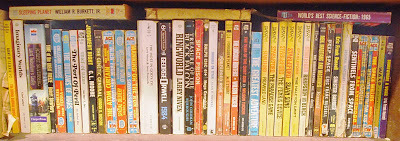
Before going on to talk about the books I was reading besides SF in the 1960's, I thought that I might as well post my complete collection of mass market SF books from not only that era, but from the 70's to 90's as well. I had to reduce two walls of bookshelves into one, and I'm afraid these books were not a priority. As a result, they ended up on the bottom shelves, piled up between the wall and the bookshelf, and then along the top of the bookshelf, where it was just an inch or so too low to stand them up -- a situation far from idea, but necessity must be served.
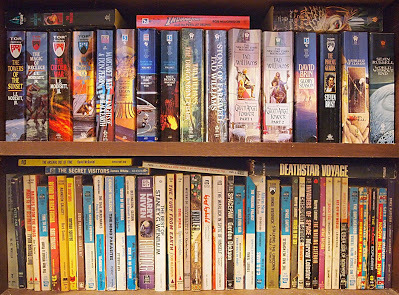
Above, my very modest fantasy shelf, and above it, but not shown, is my Garret PI collection and a handful of other Glen Cook books take up a shelf. Books are in no particular order, though I have tried to keep the books of an author together.
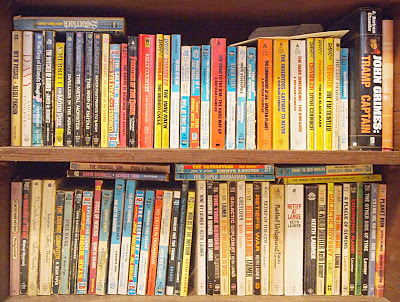
Notable on the shelves above is my collection of A Bertram Chandler's John Grimes series of books. That is one of the few series of stories that I read and enjoyed once again as an adult. The fact is that I missed many of them when they were published, which meant that I had to go back and collect them later. Above this shelf, but not shown, is a whole shelf of Edgar Rice Burroughs books which I featured previous post.
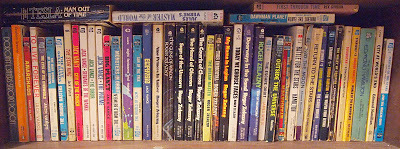
Some books by authors at the end of the alphabet -- Vance and Zelazny each with a series that I do remember something about -- Vance's "Planet of Adventure" series, and Zelazny's first Amber series.
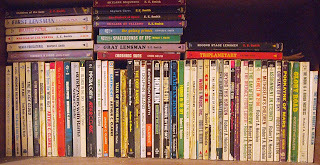
Above, classic SF books here -- my collection of E E Smith, Arthur C Clarke, and Heinlein books
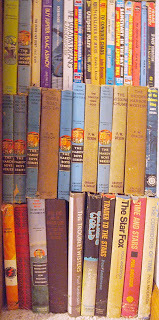
Now we're going up the side of the bookshelf between the wall and shelving. Odds and ends at the bottom.
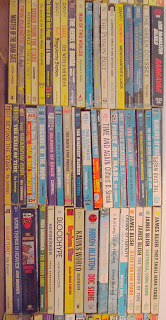
James Blish Cities in Flight series stands out here along with a sample of the old stories reprinted in books from Ray Cummings and John W Campbell that were common in this period. Plus the book, The Blind Spot, which I remember as being very unusual, though the story largely escapes my memory
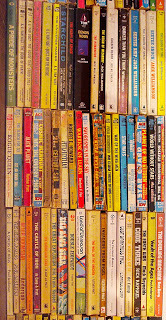
Fletcher Pratt, De Camp, and Paul Anderson books are featured in this photo.
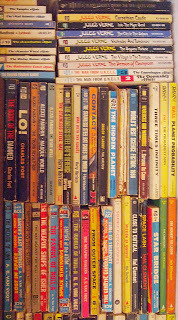
Jack Williamson, Van Gogt, and Jules Verne are the standout authors in this photo, along with two of Charles Fort's books. We've now reached the top of the bookshelves and will slide back along the top.
We also get a glimpse of my collection of The Man From Uncle books, half hidden behind the SF books along the top of the bookshelf.
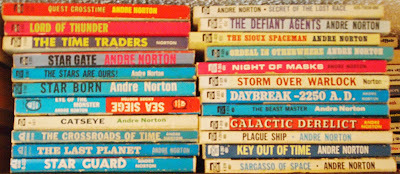
Most of my Andre Norton Collection. I am amazed at how many books she wrote and I never read -- even during the time I was reading so much SF. I think that after Witch World I fell out of love with Andre Norton, probably because they were less boy's own adventure stories -- the type of stories that appealed to me.
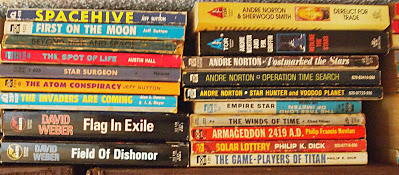
Here we begin to see some of the SF books I picked up likely in the 1990's. I have 8 Honor Harrington books. I stopped reading those after I found myself rooting for the "socialist" Peeps and realized that they would never win.
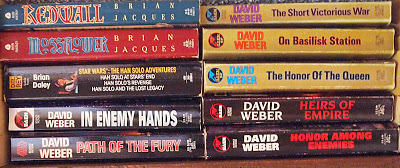
More Honorvers books, and two Redwall books.
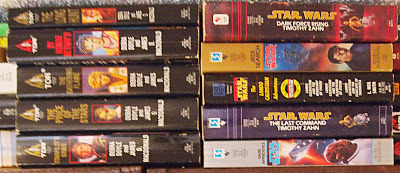
My modest StarWars collection, and the Mageworlds Series from my brief flare of interest in paperback SF books in the mid-1990's.
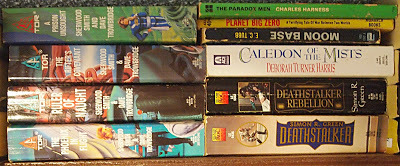
And finally, the last of my 90's books, what books I have of the Exordium series, and two books of the Deathstalker series. I was finding SF books in general to dark and grim for my taste in this period, so that my interest in SF waned and I stopped dropping by the local bookstore. I also realized that I had way too many books, and that one day I, or my heirs, would have to either move or dispose of, so that I only have acquired a couple dozen books in the last 20 years, and instead relied on the library for my reading pleasure. And I did have to move them, and it was heavy work, indeed.
And with that, we've completed my collection of mass market SF paperbacks. Next post I will talk about the other books I was reading in my teen years and the effects they had on my reading going forward in my life.
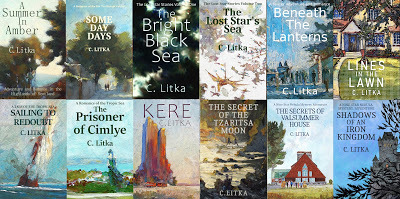
July 29, 2021
The "Must Read" SF I Haven't Read
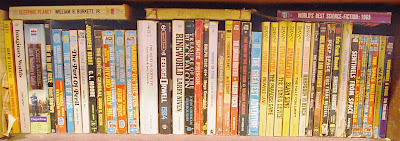
I’ve been watching a few Youtube channels devoted to science fiction/fantasy books. Watching them got me thinking about my collection of SFF books. I have a lot of them – the illustrations are shots of my SF shelves – but nevertheless, I seemed to have missed most of the important SF for various reasons that I’ll explore in this post and the ones that follow.
I have already mentioned in previous posts, that while I had always considered myself a fan of SF, it turns out that I wasn’t really a fan of SF after all. Instead, I was, and still am, a fan of the old school romances – adventure stories set in exotic lands. SF merely provided the exotic lands element. I now have the numbers to prove it. And numbers never lie.
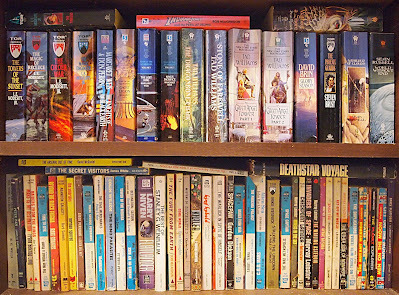
I’ve looked over seven lists of the “Best 100 SF novels” that I found online. Some of the lists are weighted to older books, others to newer books. Below are how many of those books I read off of each list, plus the ones I started but did not finish.
NPR’s 100 Read 17 DNF 5
Stacker 100 Read 16 DNF 2
Reedsy 100 Read 11 DNF 2
The Planet 100 Read 13 DNF 4
Book Authority 100 Read 6
Rapid Transit 100 Read 12 DNF 2
SF List (pre-2000) Read 14 DNF 3
For a fellow who has read more than 500 SF books, reading 6% to 17% of the genre’s most important or essential books is not a very impressive number. Clearly I hadn’t got the memo about what SF is really about. Though to be honest, I’ve no plans to rectify that situation.
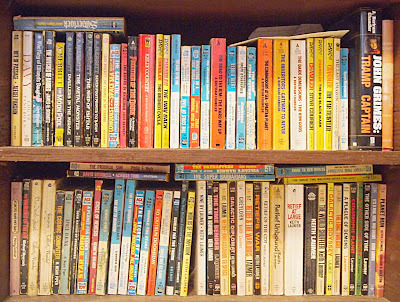
Just as a side note, the two most mentioned books on these lists that I started to read but did not finished are A Canticle for Liebowitz and The Foundation series. I tried A Canticle for Liebowitz within the last decade or so, and it failed to entertain. Though I was never a big Asimov fan, I also did try reading my old copy of The Second Empire, but found it as dry as dust. Perhaps the two things in common with these books is that they are not tied to one set of characters. I am a character focused reader, and writer. These books were more of the classical SF idea focused, especially the Foundation. Plus, they're stories span centuries. I’m also not a saga reader either. I like books on a human scale rather than that of a god.
I also looked up the “must read" or "essential" SF books on seven booktubers episodes on Youtube and combined those lists with the top 10 books on the above lists above to come up with a short list of the most recommended SF books I should’ve read. The most often mentioned book on this list is Dune, and by a long shot with 12 recommendations. Little wonder it gets two movies. I must be one of several SF readers who have not read Dune. 1984 was the next most recommended book, with 8 recommendations. I actually read1984 while still in grade school, sinceit was one of the books we had around the house.The Foundation and Fahrenheit 451 followed, each with 6 recommendations. I don’t believe I’ve read a single Ray Bradbury book. His Martian Chronicles is also mentioned on this list. I, Robot and The Hitchhiker’s Guide to the Galaxy followed, each had 5 recommendations. I have read The Hitchhiker’s Guide, though I can’t say I’m a hugefan of it. I also tried reading Terry Patchett, but I guess I'm not a great fan of the absurd.
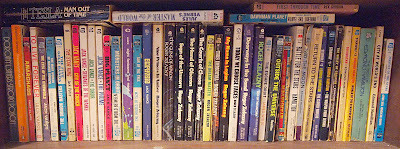
Do Androids Dream of Electric Sheep? made these lists with 4 recommendations, which I haven’t read. I have only a couple of Dick books on my shelf. The Domesday Book was also mentioned on some lists, which I did read and enjoyed, plus several more of her books.
Other books on these lists include War of the Worlds and The Time Machinewhich I don’t recall reading, though I have a book with both titles on my shelf. The truth is that I don’t recall reading 95% of the SF books on my shelves – a combination of 50 plus years and unremarkable stories, I guess. The lists also includes several Jules Verne books, Journey to the Center of the Earth and 20,000 Leagues Under the Seas, both of which I have read and seen the movies. Frankenstein, with 4 recommendations, is another book I've never read, though I've no doubt seen the classic B&W movies on a B&W TV at some point in my early life.
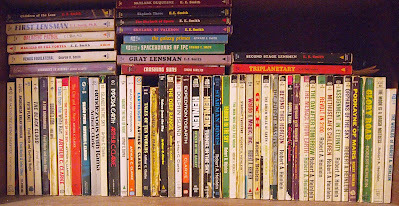
Stranger in a Strange Land is often recommended as a book to read if one wants to get into SF. I read it, back in the day. I don’t remember anything about it, save that I greatly disliked it, so much so that I got rid of my copy some years back – something I rarely ever did. The Moon is a Harsh Mistress is also recommended. I have the book and maybe I read it – I did count it in with the books I read – but it is possible that I didn’t finish it, since I’ve no memory of it. (See above.) In any event, it marked the end of my Heinlein era.
Of course everyone is free to read or give a miss to any book they please. Just because a lot of people read and like one book doesn’t mean that you need to as well. The SF books I’ve read are weighted heavily in favor of the books available in the libraries and on the mass market paperback racks of the 1960’s, when I was buying and reading SF reading as a teenager. In the following decades my taste in books broadened beyond SF, though, even in my teenage years, I was reading more than SF. I think what may have happened with my SF reading was that those other books offered elements that most SF stories did not, which led to a decline in the number of SF books I read, even though I still counted myself a fan of SF.
But more of that in the next post.
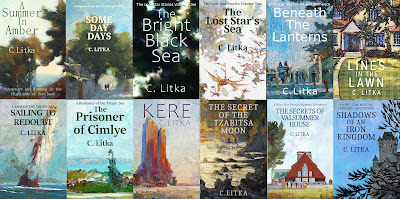
July 22, 2021
The Marvelous Mrs Maisel Review
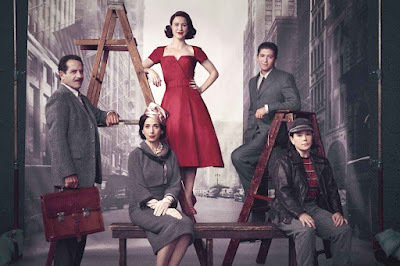 image credit: https://www.denofgeek.com/tv/the-marv...
image credit: https://www.denofgeek.com/tv/the-marv...Now that I have all my self-promoting postings out of the way, it’s time to come up with some general interest posts – an old man conversing with the clouds sort of thing.
Our credit card company gave us three free months of Amazon Prime, so my wife and I took the opportunity to watch a show that I had heard many positive things about, the 4.3 star rated The Marvelous Mrs Maisel. This is a review of the first two seasons and three episodes of the third.
About the reviewer: How any reviewer rates a work depends upon what the reviewer values in the medium. A reader needs to know what the reviewer is looking for in order to judge the value of the review for their purposes. What I value starts with relatable, likable characters – they are pretty much a necessity for me. A coherent, plausible plot, where the action flows from the characters and their situation is also very important to me. Since I primarily read and watch fiction for the purpose of escape, I value humor, and mostly enjoy light and witty fare. For a visual medium, I’d like good cinematography and sets. This review reflects my tastes.
The Marvelous Mrs Maisel
Since this show has been around for four years, I don’t think there is any need to delve deeply into the premise – a wealthy young Jewish woman decides, after her husband walks out on her, to become a stand-up comedian in New York city in the late 1950’s. There are currently three seasons of the show, with a fourth being filmed.
The cinematography, location shoots, and sets are excellent, and evocative of the time. Five stars.
I did not grow up in NY city, nor do I have any experience with the Jewish lifestyle portrayed in the show. Being Jewish is very much a key element of the show, and so it needs to be addressed. It struck me that the way the show portrayed its Jewish protagonists bordered on stereotyping them. Being a modern show, I assume that if this was the case, objections would’ve been made. None were, to my knowledge, so I'll assume that they are authentic people that have been somewhat exaggerated, for comic purposes to create a colorful portrayal of that sub-set of NY city life. As such, I found it interesting to see how these people lived.
Which brings us around to the individual characters and their actions. I found Joel Mainsel’s decision to leave his wife, the inciting incident of the series, unconvincing. The explanations offered for the abrupt action didn’t convince me that it was in his character to act the way he did, with the provocation the writers provided. Of course that plot twist was deemed necessary to the story, so necessity must be served. For that reason I’ll give it a reluctant pass. The same can be said for Mrs Maisel’s mother’s sitcom-like flight to Paris. It was just plausible enough for me to go along with it, though clearly, it was less about the character and more about the writers needing something different to write about, and a new location to film. Susie and the gangsters are interesting characters. Lenny Bruce wasn’t funny – nor were any of the other comedians. Indeed most of the stand-up comedy routines were not funny. Maybe you had to have been there...
Still, all in all, we enjoyed the first season a lot. The show began to fall apart in the second season. The action moved to the Catskills and a summer camp for wealthy adults, where the whole Maisel family spends two months each summer. A minor point: at this time Mrs Maisel was working in a department store. How a part-time employee could swing two months of vacation is a mystery. All I can say is, nice work if you can get it.
In any event, I found it amazing that places like that resort existed, (and still do?) and that there was a class of people, who were not multi-millionaires, but who had the time and money take two months off each summer go to an expensive camp, where they were fed, entertained, and otherwise catered to. The humor was probably down a peg from the first season, but it was still pretty entertaining – while they were at camp. If the series had ended with the Labor Day dance, it would’ve been a four star show for me.
But it didn’t. It went down hill fast from that episode, in part because the characters began to do things that were not in their character. They had become the mere puppets of the writers, who seem to have run out of realistic ideas for the show going forward. As a result, the writers had them doing things that simply made no sense.
If the characters, especially Mrs Maisel’s parents, had began the series almost like caricatures of well off New York Jews at the beginning of the show, by the beginning of the third season they had been reduced to furniture – stage settings – to be moved around at will to serve the silly plot the writers concocted in search of laughs. Nothing they did made organic sense. Mrs Maisel’s father would never have given up his tenured position at the university, no matter how burned out he was, especially with a sabbatical available to him, something that he had earned. He wasn't an idiot. Sorry, the beatnik/radicals in the show for two episodes weren’t motivation enough. Or humorous.
And his wife would never give up her trust fund – the only other source of income after her husband gave up his job. Give it all up because she couldn’t be on the board of trustees? Really?
These characters were simply being moved around the set willy-nilly, as the writers desperately tried to keep the show “interesting” – in a soap opera/sitcom hybrid sort of way. They only way this type of writing could be justified would be if it delivered laughs. It didn’t. Their predicament wasn’t funny, and since it was so contrived, wasn’t drama either. It was just dumb.
And then we come the Marvelous Mrs Maisel herself. Yes, she grew up in wealth and privilege, with a room full of clothes, and so she could be forgiven in the beginning of the series being bright, breezy, confident, and self-centered. But, as the show progresses, she experiences the underside of NYC life, where people have to struggle to survive, where people are oppressed and marginalized. She occasionally sees how poor her manager is, and yet none of this seems to make much of an impression on her. She doesn’t grow in the story, remaining blind to the plight of others, selfish, and self-centered. And never more so when it comes to her two young children.
I have to wonder why they included the children in the show in the first place, since they seem to get in the way of the story – when they weren’t being completely ignored – which was most of the time.
At the end of the second season Mrs Maisel instantly agrees to going on a six month tour, never considering, even for a moment, who will look after her children when she is on tour. She simply assumes that someone, other than herself, will look after them for her – as if it was due her. (As someone has been doing all along.)
Now, I’m not saying that this isn’t necessarily an unrealistic portrayal of a person like Mrs Maisel -- a person with a laser focus on obtaining fame and fortune and damn anyone who gets in his or her way. Perhaps we are meant to admire her for her ambition and drive. But even so, her failure to respond to her new life and grow as a person throughout the series – when she should’ve – makes her an increasingly unlikable character, in my opinion. I was no longer invested in her success. For me, this was a fatal flaw in the story, though it may not be for you.
The third season – of what we saw of it – went even further down hill. It was padded with a number of long, dumb, musical numbers, it wasted time on various not-funny interludes, and unrealistic situations -- the type of situations that exist only because characters, for some reason, don't talk about it to other characters. We gave up on the show after episode 3, as we no longer cared what happened to Mrs Maisel.
The Marvelous Mrs Maisel began well – bright, snappy, and funny – and went down hill, slowly at first, and then fast. Watch the first season – and maybe the second until the Labor Day dance. And stop.
Final verdict: **
What's your take on The Marvelous Mrs Maisel?
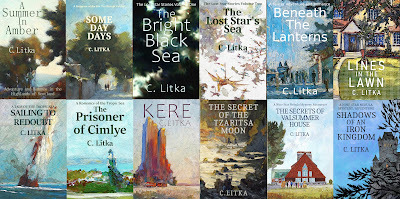
July 15, 2021
Map for Shadows of an Iron Kingdom

I don't really know if a reader actually needs a map, but I always like a map in my books, so here's a sketch map for Shadows of an Iron Kingdom. It's not to scale. I did this map entirely digitally on Gimp.
Shadows of an Iron Kingdom and The Starfaring Life are now available
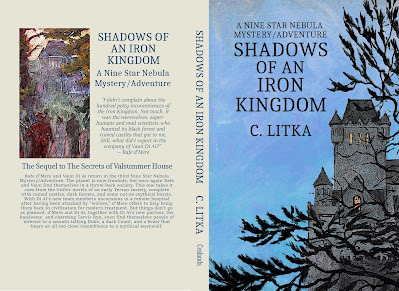
The ebook of the third Nine Star Nebula Mystery/Adventure, Shadows of an Iron Kingdom, is now available on Amazon for $.99 and on Smashwords for Free. Within the next few days it should also be available on Google, Apple, Kobo & B&N for free as well. The paper edition is priced at $10.00 on Amazon.
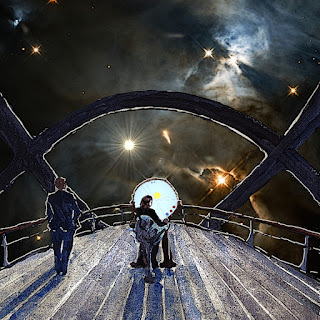
My novella length serial story, The Starfaring Life, is now available on Amazon's Vella platform. It can be read on the Amazon site here: https://www.amazon.com/kindle-vella/product/B0989VDP6N
It can also be read on an iOS Vella app which will allow it to be read on your iPhone or iPad. The first three episodes can be read for free, after which you will have to spend tokens, one per hundred words, to read the rest. I believe that at least on the app, Amazon is offering 200 free tokens at launch, which if true would allow you to read almost the whole story for free.
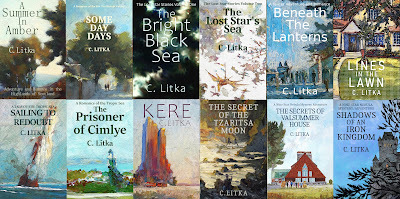
July 8, 2021
Odds and Ends
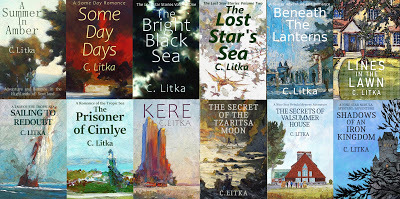
Since I’ve taken some time off from writing, I’ve been spending my time doing other things. One of my major projects this week was to rework the covers for my older paperback books, A Summer in Amber, Some Day Day, The Bright Black Sea, The Lost Star’s Sea, Beneath the Lanterns, and Sailing to Redoubt. I wanted to bring them in line with my more recent covers, i.e. without the title boxes. I have the process of creating covers pretty well down, and having old covers around that I could just drop the new artwork over for the final step before making a PDF of the cover, saves a lot of time. Still, it served to pass a few hours over the course of a couple of days.
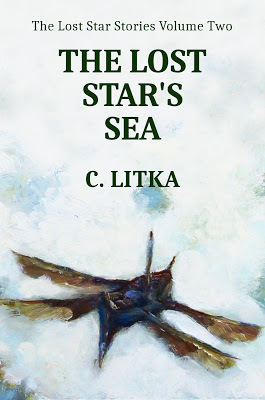
The Lost Star’s Sea paper edition received new cover artwork (above) and its ebook edition got a new, smaller, title font. Both editions of Sailing to Redoubt now have an island in the background (below).
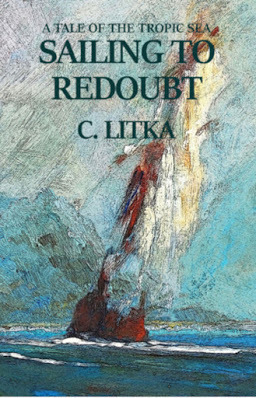
Good copies of these had been uploaded to Amazon before I decided that I needed to backup all my files. Instead of doing it one by one, I tried to do it all at once, and somehow lost the entire folder of all my files for my books when I interrupted the process. I have backup files, but I was lazy and did not back up the art for the latest covers, so the files for the newest covers seem to be beyond hope. Now, if all goes well, I won’t need those files again, but losing them was enough to tear my hair out in frustration. If I had any.
Looking ahead, next week should be a big week. The ebook edition of Shadows of an Iron Kingdom will be released on Thursday, 15 July 2021. Amazon also informed us that next week the Vella program will launch – with 20 episodes of my The Starfaring Life included. I have very low expectations, so I pretty certain that I won’t be disappointed, and I’m not certain I really want to be surprised either. I guess it will be what it is, and we’ll know soon enough.
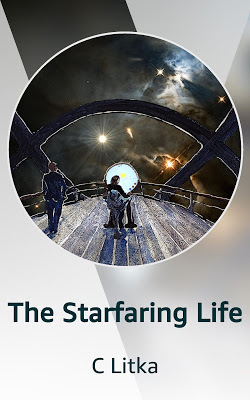
July 3, 2021
What's Up Next
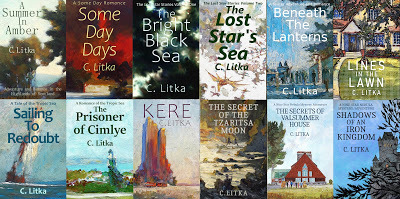
Below is the post that I had planned to post yesterday. It is still valid, but with, let's say a "*" which I will add below.
Shadows of an Iron Kingdom, the third Nine Star Nebula Mystery/Adventure ebook is now on pre-release on Amazon at $.99, while the paperback version is available now, for $10.00. The ebook will be released for free on Smashwords and Google on 15 July 2021, and will make its way to other retailers for free shortly after that,
At a date yet to be announced, but sometime mid-to-late July, The Starfaring Life serial will be live when Amazon flips the switch on it Vella app for iOS. With those two releases, I’ll have cleared my desk of projects.
In the past 18 months or so, since January 2020, I’ve written and released four novels, two novellas and a short story. While this is not on par with the big time, mainstream producers of Kindle Unlimited books, it is, I think a pretty darn good pace. The key, of course, is the length of the novels. All four of the novels have word counts that range from 54K words to just over 72K words, with the novellas coming in at 34K and about 25K words each. It is a simple fact that the longer the story, the more moving parts you need to fill it. Developing all those moving parts is, for me, time consuming. As long as I have a story in my head, I can type it out at between 1,000 and 2,000 words a day in about four hours, split between two hour morning and an evening sessions. This means that it takes only an extra month or so of typing to go from a 60-70K to 100-110K word story. What takes the extra time is coming up with a more complicated story. In the past, my 100K+ word stories took between six months and a year plus to produce. But a 60-70K story takes me just two to three months to produce, once I have the story in mind, and with fewer moving parts, they are a lot easier to dream up.
But after four short novels and a couple of novellas, I want to write a longer, more ambitious story again. And I want to write something different. Now, I always want to write something different with every story, but this time I want to write something, shall we say, rather different. I have some ideas, but they are rather contrary. I’d like to write something sort of clever and comic. The story idea however has the characters discovering an ancient secret guarded by a shadowy organization – a pulp story idea. And I want write something more literary as well. I have my work cut out for myself, so don’t expect this new story until sometime in 2022, assuming I can, in fact, work it out.
The wild card, however, is that I like to fill several hours of my day typing – writing – so that if the daydreaming up of this new story takes too long, I might be tempted to pick up one of the many threads I’ve left dangling from most of my stories, and do another sequel. Guy Mons needs to move on from where I left him. Taef Lang needs to find a job. Wil Litang needs to be reunited with Naylea Cin, Ren Loh isn’t going to let Kel Cam just settle down and teach. I know that Rafe d’Mere and Kee will find a mystery to solve in space… But all these threads are just that – threads. I’d need to make a story out of them, which I don’t have a present.
*I had ordered a new mechanical keyboard for myself -- a new toy -- for all that work I've put in over the last 18 months. It was out of stock, and I hadn't expected it to be back in stock any time soon -- I figured they were stuck in some container in China. But, lo and behold, it became available, and arrived yesterday. And so I have this new toy in hand and need to play with it. I got to thinking about one of those loose threads, and how I really want to fill up my mornings... I have at least 1/3, maybe 1/2 of a story in my head already, plus I sort of know what I want to do with the second half of the story, but, as usual, the devil is in the details. Still, there's no reason why I can't work on both stories, write one while continuing to dream up the second.
The bummer is that the "H" key on the new keyboard does not work... which means that my new toy doesn't work and will have to be replaced. Hopefully it will be replaced, but how much of a hassle it will involve remains to be seen, since I'm dealing with a Chinese company and it was shipped directly from China... Still, even without my new toy, I think I will continue to press on to see if I can't get the smaller project out this fall before starting typing on the big project.
